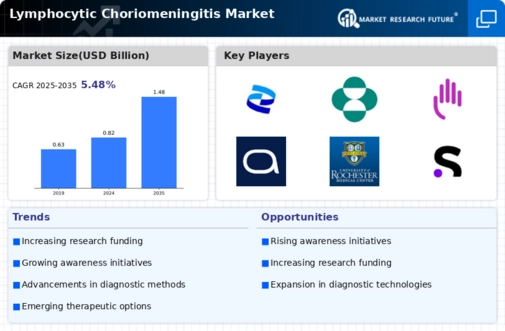Rising Public Health Initiatives
Rising public health initiatives aimed at controlling vector-borne diseases are likely to impact the Lymphocytic Choriomeningitis Market positively. Governments and health organizations are increasingly implementing strategies to educate the public about the risks associated with LCMV and the importance of preventive measures. These initiatives often include community outreach programs, which aim to reduce rodent populations and minimize human exposure. As awareness grows, the demand for diagnostic and therapeutic solutions is expected to rise, thereby driving market growth. The proactive approach taken by public health entities suggests a commitment to mitigating the impact of LCMV, which could significantly shape the Lymphocytic Choriomeningitis Market.
Increased Funding for Research Initiatives
In recent years, there has been a notable increase in funding directed towards research initiatives focused on Lymphocytic Choriomeningitis Market. Governmental and non-governmental organizations are recognizing the need for comprehensive studies to better understand the virus and its implications. This influx of funding is likely to enhance the development of vaccines and therapeutic agents, which could significantly impact the Lymphocytic Choriomeningitis Market. Furthermore, as research progresses, new insights may lead to innovative diagnostic tools, thereby expanding the market landscape. The commitment to funding research initiatives indicates a long-term strategy to combat LCMV, which is expected to yield substantial benefits for the Lymphocytic Choriomeningitis Market.
Technological Advancements in Treatment Options
Technological advancements in treatment options are emerging as a crucial driver for the Lymphocytic Choriomeningitis Market. Innovations in antiviral therapies and supportive care are being developed to address the complexities associated with LCMV infections. For instance, the introduction of novel antiviral agents has shown promise in clinical trials, potentially improving patient outcomes. Additionally, advancements in telemedicine and remote monitoring technologies are facilitating better management of LCMV cases, particularly in underserved areas. These developments not only enhance treatment efficacy but also broaden access to care, thereby influencing the overall dynamics of the Lymphocytic Choriomeningitis Market.
Emerging Markets and Increased Healthcare Access
Emerging markets are presenting new opportunities for the Lymphocytic Choriomeningitis Market. As healthcare access improves in developing regions, there is a growing demand for diagnostic and treatment options for LCMV. Increased investment in healthcare infrastructure is facilitating the introduction of advanced medical technologies and therapies. This trend is particularly evident in areas where LCMV is endemic, as local healthcare systems strive to enhance their capabilities. The expansion of healthcare access not only addresses immediate health concerns but also fosters a more robust market environment for LCMV-related products and services. Consequently, the evolving landscape in emerging markets is likely to play a significant role in shaping the future of the Lymphocytic Choriomeningitis Market.
Growing Incidence of Lymphocytic Choriomeningitis
The rising incidence of Lymphocytic Choriomeningitis Market (LCMV) is a pivotal driver for the Lymphocytic Choriomeningitis Market. Reports indicate that the number of reported cases has been increasing, particularly in regions where rodent populations are prevalent. This uptick in cases necessitates enhanced diagnostic and therapeutic solutions, thereby propelling market growth. The LCMV is primarily transmitted through contact with infected rodents, which suggests that urbanization and changes in land use may contribute to higher exposure rates. Consequently, healthcare systems are compelled to allocate more resources towards research and treatment options, further stimulating the Lymphocytic Choriomeningitis Market.


















Leave a Comment